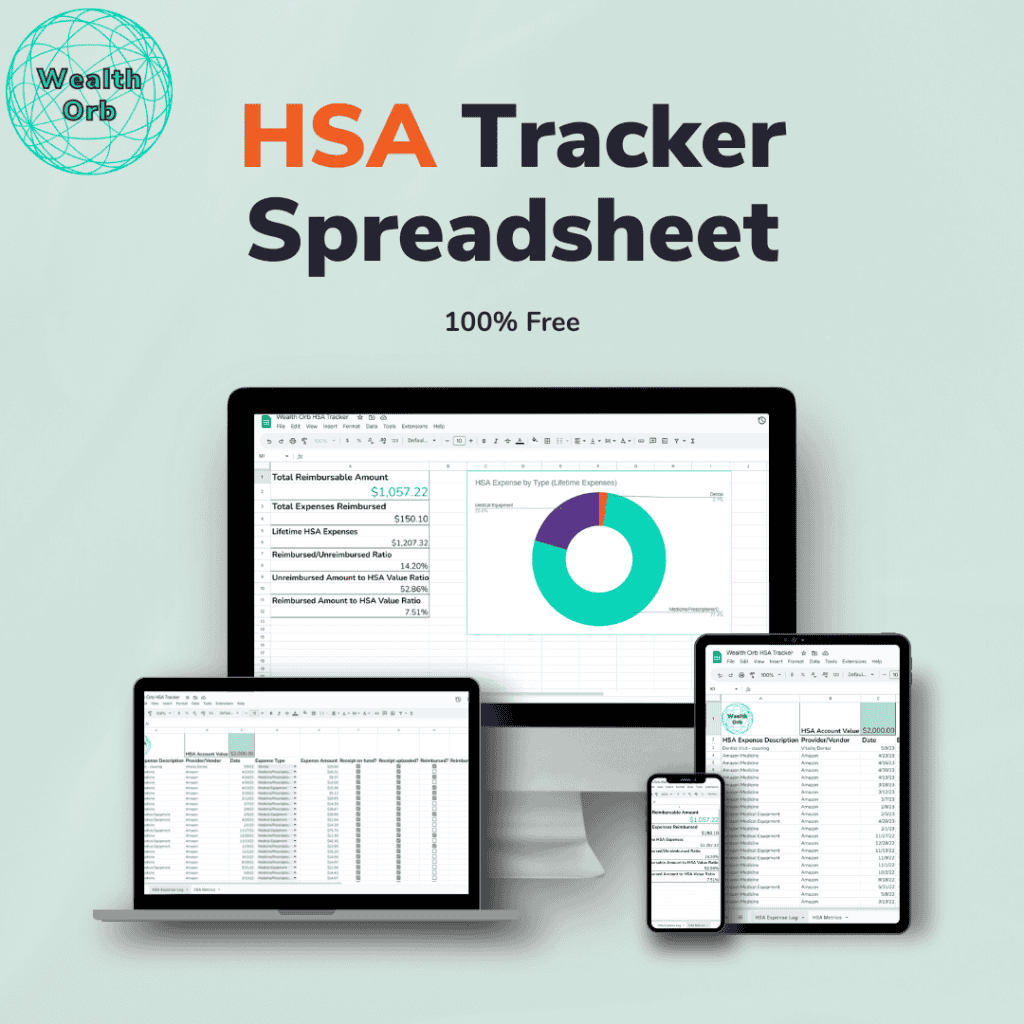The Health Savings Account (HSA) is my favorite retirement account. It is triple tax-advantaged and has benefits no other retirement account can compete with. Its versatility gives us extra levers of flexibility with generating “income” at anytime, and an extra vehicle in which to contribute pre-tax dollars and defer taxes into the future. In fact, it is such a strong account that the one of its only drawbacks is its maximum contribution limit on an annual basis.
The great news is that the IRS announced plans to increase 2024 HSA contribution limits to $4,150 for singles and $8,300 for families, the largest increase since 2024. There’s never been a better time to plan to leverage this account as a tool to elevate your personal finances. In this post, I’ll show you how to get the most out of this incredible investment account!
This article will discuss specific strategies for an HSA which you control. These strategies do NOT apply to an FSA which is a different type of account that requires you to spend the money within a set timeframe or forfeit your contributions.
Disclaimer: Like everything on my blog, this post is NOT financial or tax advice and is meant for educational & entertainment purposes only. I am not a financial advisor or tax professional, just a personal finance nerd who loves to hyper-optimize and build systems that create wealth. Do your own due diligence and speak with a financial advisor/tax professional.
An HSA and the strategies contained in this post are not a good fit for everyone. It can be demanding on your finances to take maximum advantage of these strategies, but I do offer an alternative for those who have an HSA and high-deductible plan and do not yet have the means to leverage 100% of the strategies contained in this post.
The triple tax advantage of an HSA
- Contributions are made to the account with pre-tax money and reduce your taxable income.
- You will not pay taxes on any investment gains in the account until you withdraw money as an ordinary distribution at or after age 65.
- You will not pay any taxes on money withdrawn from the account at any age if they are withdrawn for a qualified medical expense.
To access an HSA, you need a high-deductible healthcare plan, which admittedly isn’t the right option for everyone’s financial situation. In 2023, the minimum deductible to qualify as a high-deductible plan is $1,400 for single folks, and $2,800 for family plans.
Even with a high-deductible health care plan, to take full advantage of the strategies in this post, you need to have enough cash on hand to pay medical expenses out of pocket (and hit your plan’s high deductible) AND make contributions to your HSA with pre-tax dollars.
Your HSA balance will always roll over year after year with no limit. You control the money. Even if you switch employers, you keep the account and can continue to contribute to it as long as you have an eligible high-deductible health plan.
The HSA is an incredible tax-advantaged account that offers the strengths of a 401k and versatility that can’t be found elsewhere.
One of the primary strengths in an HSA is that it can be used to invest, and that by tracking medical expenses and paying them out of pocket, you can choose when to reimburse yourself anytime in the future. That means, for example, you can record a medical purchase today, and reimburse yourself for it 20-30 years in the future. You have 100% control over when you choose to reimburse yourself for your expenses that happened years or even decades ago.
Build Potential Cash Energy by savings your receipts!
Generous reimbursement rules with a HSA creates a wonderful opportunity to double dip. Since almost all medical providers and vendors accept credit cards, you can pay for medical expenses with credit cards, earn rewards, and then reimburse yourself in the future when your HSA funds have had a chance to compound greatly.

The strategy we want to employee to get the most out of an HSA is building Potential Cash Energy (PCE) within our HSA account.
Start by recording all your eligible medical expenses paid out of pocket with cash or credit card. After the money used for these eligible contributions has had a chance to compound with your HSA investments, you can choose when to cash it out and convert it into Kinetic Cash Energy (KCE).
It’s like stashing away barrels of gunpowder and holding the detonator. You can ignite the gunpowder (PCE) and turn it into cash (KCE) instantly.

The flexibility in your HSA is a beautiful thing. By the time you want to take income (reimbursements) from your HSA after it has had time to compound and grow, you will have forgotten that you paid all those medical costs out of pocket in the first place. You will not pay taxes to reimburse yourself, and can take this money out of the account at any time you choose. How about using some of that cash you worked hard to save to take an expensive vacation with your family?
You can go digging for hidden cash in the past
This strategy only applies to expenses that you paid via cash or personal credit card/debit card. If you used your HSA debit card to pay them, you can’t reimburse yourself in the future for that purchase (it already came out of your HSA).
Most of us throw away receipts from the grocery store after a while. I myself have lost out on hundreds of dollars in eligible medical expenses at the grocery store that have gone to the landfills. But there’s no use in fretting over lost opportunities. Instead, we can create new opportunities going forward!
Fortunately, all hope is not lost. Chances are, you’ve bought some stuff on Amazon or other online retailers that count as an eligible HSA expense.
Here’s a handy list of all things eligible as a qualified medical expenses. It pays dividends to spend a little time reading it through at least once so you know what you can track and convert to PCE.
Comb through your Amazon/online order history and look for eligible purchases. I spent a couple hours going through my order history back through 2019 (when we got our HSA) and found over $1,000 in eligible expenses to record and add to our PCE. Amazon even has its own HSA store that shows you exactly what kind of things are HSA eligible as a qualified medical expense if you want to double check to make sure the expense you log are legit.
I found even more money as I went digging through my email looking for old medical receipts from providers.
After exhausting the past and digging for extra PCE, look to the future by making it a point to log all of your HSA-Eligible expenses at least once a month. Better yet, do them when you get home from the store, doctor, or dentist. Build up your PCE by paying for as many of your medical expenses out of pocket all while maxing out your HSA contributions as able and investing the balance. Optimize the strategy even further by using a rewards credit card responsibly.
Why should I pay medical expenses out of pocket while I have all this money in my HSA?
Because you give the money time to compound and grow and do so in an extremely tax-efficient manner. Let’s run a simple example scenario.
You have a HSA with $10,000 invested.
Scenario A: You have an emergency medical expense that costs $5,000 and decide to pay it with your HSA debit card. Your HSA balance is now $5,000 and you let the account sit for 20 years, invested in the market earning 7% without making any additional contributions to your HSA account. After 20 years, your account is worth $19,348.42.
20 years after the expense you reimburse yourself the $5,000 and now you have $14,348.42 remaining in the account. The original expense is 34.8% of the remaining value in your HSA investment account.
Scenario B: Same situation as before, except this time you choose to pay the emergency medical expense out of pocket.
As a nice bonus for being a Wealth Orb reader, You earn $100 in cash-back rewards by putting the medical expense on your rewards credit card earning 2% then pay off the balance in full.
Your HSA balance is still $10,000 and you let the account sit for 20 years, invested in the market earning 7% without making any additional contributions to your HSA account. After the 20 years, your account is worth $38,696.84.
20 years after the expense you reimburse yourself the $5,000 and now you have $33,696.84 remaining in the account. The original expense is only 14.8% of the remaining value in your HSA investment account.
Both of these scenarios assume you never add additional contributions to the HSA. If you do, expect an account that can end up in the hundreds of thousands of dollars range (or even more) by traditional retirement age.
By paying your expenses out of pocket and letting your HSA grow, you can take advantage of the account’s triple tax advantage status and choose exactly when to pay yourself and how to use the money. You also have a larger HSA balance to cover eligible medical expenses tax-free later down the line.
I hope this post illustrates how powerful the HSA can be as an investment vehicle.
Track your HSA expenses and PCE/KCE with my 100% free HSA expense tracker spreadsheet

I genuinely want to help you elevate your personal finances. That’s why I’m more than happy to give you this spreadsheet completely free of charge. It’s simple, but it does the trick.
No tricks or BS, no need to join my Newsletter (though I’d love to have you), just a 100% free link to this simple spreadsheet so you can use it for yourself. Includes easy instructions on how to use it: https://docs.google.com/spreadsheets/d/1Gx0CZE4FQfuzGY9x7aGORXBmtB-6gBvOdCh8mV7Hcug/edit?usp=sharing
What if I can’t pay medical expenses out of pocket after maxing out my HSA?
Even if you can’t pay for all your medical expenses with cash after maximizing your HSA contribution, it still makes sense to try to max your HSA contribution. (Investment priority: Employer 401k match %, max Roth IRA, max HSA, max remaining 401k and so on… investment priority is a lengthy topic for another blog post).
With a high deductible health insurance plan, any medical expense you do pay with your HSA debit card effectively gets you a 19-37% discount on your medical costs depending on your income bracket. This is because all contributions you make to your HSA are done with pre-tax dollars and reduce your taxable income at payroll. You’re spending pre-tax dollars on after-tax expenses.
Another thing to note is that it’s okay to dip into your HSA in the case of a rainy day. Try to prioritize your normal rainy-day emergency savings before dipping into an HSA balance, but don’t be afraid to use the HSA to cover unexpected medical emergencies if they threaten to sink your financial ship. It’s better to try to retain your emergency fund when possible unless you are confident you can refill it quickly.
Additional HSA tips
Don’t use your HSA for ordinary income distributions and non-qualified expenses
The HSA isn’t designed to generate ordinary income or distributions outside of qualified expenses until later in life.
Unlike most retirement accounts that allow you to take ordinary income and distributions at age 59 & 1/2, you will pay a 20% penalty on top of ordinary taxes for non-qualified distributions on your HSA prior to age 65. Make sure to only reimburse yourself for eligible medical expenses or use your HSA to pay for medical expenses via your debit card when the time comes. This does not affect the reimbursement strategy discussed above in which you will pay no penalties on qualified expenses.
Don’t pay a ridiculous penalty by using the account incorrectly.
Take advantage of your employer’s contributions
Maximize your HSA contribution. If you’re not sure how, talk to HR at your company and make sure you are contributing everything you can to hit the yearly limit (if possible).
💡🚑 Make sure you INVEST with your HSA. This requires you to actually choose to invest your HSA funds in investments within the account portal. If you don’t manually do this, your balance will likely sit as cash and erode with inflation. Make sure you are 100% certain your balance is invested. Choose low-cost index funds so fees don’t eat into your long-term investment gains.
Fortunately, many employers will contribute to your HSA if you have one. Unlike 401k employer contributions, an employer contribution to an HSA does count against your annual limit. Even though you will be able to contribute less, this is still free money because employer HSA contributions are generally non-taxable to employees. This is an additional form of compensation and part of your overall benefits package for having a high-deductible health plan.
💬How are you investing for your future with your HSA? Have any questions or comments? Join the discussion in the comments sections below!








Comments